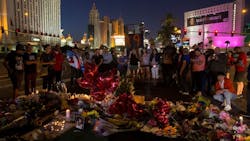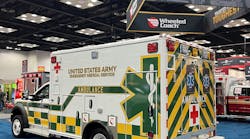It's difficult to forget the images of chaos that unfolded Oct. 1, 2017, as shots rang out while over 22,000 people were gathered at the Route 91 Harvest Festival along the Las Vegas Strip.
The gunfire that rained down on the crowd from a room on the 32nd floor of the Mandalay Bay hotel continued for over 10 minutes, causing the deaths of 58 people and injuries to more than 850, including first responders who were off duty attending the festival and on duty as part of the response.
The onslaught that night by shooter Stephen Paddock, who took his own life before authorities closed in on him, resulted in the deadliest mass shooting in U.S. history and has led many fire departments nationwide to begin changing their approaches on safety—providing ballistic gear to firefighters, for example—and training more frequently for active shooter incidents.
While the coordinated response led by the Las Vegas Metropolitan Police (LVMPD) and the Clark County Fire Department (CCFD) was by all means "exceptional," an After Action Report released this week by FEMA also examines areas for improvement and offers several key recommendations.
The three primary conclusions of the report that public safety agencies should note before digging into more specific recommendations are as follows:
- Strong cross-agency collaboration is critical for a quick and effective response.
- Response training tailored to address incidents of mass violence are an especially valuable investment.
- Coordinated, cross-agency planning for these incidents is necessary for successful outcomes.
The primary element of responses to such large-scale incidents that is typically lost amid the media narrative is how complex they are. The Vegas shooting brought together 13 responding agencies and three private ambulance companies, so the recommendations in the report touch on not just law enforcement, fire and emergency medical personnel but also dispatch, communications and the incident command structure.
- FHWorld18: Response Efforts at the Las Vegas Shooting
"Across several elements of the response, strong collaboration among these organizations was critical to the speed and effectiveness of their efforts," the report reads. "Conversely, when responders encountered communication barriers, these barriers hindered some aspects of their response coordination."
"The importance of coordinated planning across agencies cannot be understated in terms of its impact on this response."
Below you will find some highlighted recommendations that cut across varying elements to the response.
Law enforcement, fire & EMS responders
- The first CCFD unit on scene successfully requested necessary resources, but command and a staging area were not established until a battalion chief arrived shortly after the onset. While training that further enhances the incident command system and multiple casualty incident (MCI) response is recommended, the actions expected of the captain who arrived first were understandably difficult due to a focus on immediate response needs.
- In the initial stages of the incident, public safety personnel self-deployed and converged on the scene, assuming response roles without first reporting to the staging area, which created issues of maintaining personnel accountability. It is recommended that the possibility of self-deployment be recognized and that personnel be encouraged to first report to the staging area.
- The large number of private ambulance transport companies that responded made command and control difficult. It is recommended that private ambulance companies be integrated into planning and training for large-scale events and made part of the incident command structure. A supervisor or liaison for private EMS providers is also encouraged to be present at the command post.
- Civilians played a large role in assisting with basic medical treatment and transport of victims, but the presence of alcohol and general panic among the large crowd caused security concerns and several altercations at medical tents. Medical tent security protocols should be established, but civilians should not be discouraged from rendering aid if they are capable, and community programs such as "Stop the Bleed" should receive continued support.
- Some law enforcement personnel took on EMS roles early on, conducting staging and making triage decisions. Even though they performed well under trying circumstances, coordination and communication plans should be implemented between LVMPD and EMS providers to improve outcomes.
- The North and South staging areas were not managed effectively and the EMS branch director's role was assigned twice. The branch directors failed to inform incident command of their operational ineffectiveness, so it is recommended that protocols be put in place to pre-designate command staff assignments for all MCI responses. Multi-disciplinary training should also be implemented for MCI staging.
- The operations chief advised the South Branch to release fire units to return to service, but the order was given while crews were performing floor sweeps of the Mandalay Bay. The decision left remaining law enforcement understaffed with several hundred more rooms to search. A demobilization plan that includes forecast operational needs should be built and the incident commander must have final approval on the release of any units.
Dispatch & communications
- While the LVMPD and Community Ambulance were both operating at the event, the CCFD was not integrated into the special event plans or operations, so fire departments are encouraged to form partnerships with event promoters to better coordinate pre-event planning.
- It is also recommended that venue promoters and operators hire not only law enforcement but fire departments as well to create a unified command post. Plans and policies should be put in place to help create this command structure.
- Since LVMPD Communications was aware that the festival was taking place but the Fire Alarm Office (FAO) was not, it is recommended that the fire department dispatchers and personnel always be made aware of large or high-profile events.
- Communications supervisors will benefit from additional training and support to effectively manage an incident of this magnitude. However, plans for such training were in the early stages of implementation at the time of the incident.
- The FAO and LVMPD should consider merging dispatch centers into one main emergency communications center to prevent the potential loss of critical information and provide face-to-face communications during critical incidents.
You can read the entire 61-page report here.
Active Shooter/Mass Shooting Resources:
- Berkowsky: Active Shooter Event Response
- La Mantia: MCI & MPI Preparations
- Perrigo: When Training Meets Reality: Orange County Active Shooter Training
- Ludwig: Las Vegas Changes Everything
- FHWorld: Response Efforts at the Las Vegas Shooting
- FEMA Releases Report on Vegas Shooting
- Vernon: Fire/EMS Response Considerations for Mass Shooting Incidents
- LeDuc: Planning for Your Active Shooter Response
- Mageria: The 'Omega Plan' for Firefighter Safety at Shooting Scenes
- FHExpo: Fire Chiefs Reflect on Pulse Nightclub Shooting
- Siebert: Protecting the Protectors
- Ludwig: EMS: The Active Shooter: Coming To a Community Near You?
- Ludwig: The Active Shooter: A Special Challenge
- Vernon: Fire and EMS Response to Mass Fatality Incidents
- Furey: Dispatch Protocols For Active-Shooter Incidents






